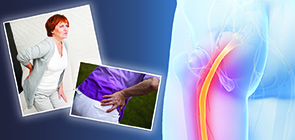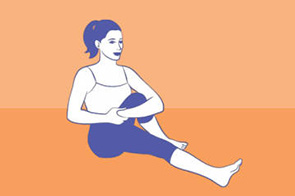
Sciatica describes pain felt along the sciatic nerve, which runs from your lower back, down through the buttock, hamstrings and into the lower leg. The sciatic nerve is the longest nerve in the body.
Sciatica is characterised by pain, numbness, and weakness in the legs. Commonly pain and numbness are located at the calf, foot, or back of the thigh. This is usually preceded for a few weeks by lower back pain. Eventually the leg pain becomes worse than the back pain. Pain can either be dull and aching or can be a shooting pain down the leg all the way to the toes. This pain can last for several days or weeks or it can subside for even a few hours. However, someone who has had sciatica for a long period of time will find that the pain localises in the buttock and thigh. In severe cases it can damage nerves and reflexes or cause the calf muscle to deteriorate. All patients are unique with their pain and presentation.
While the diagnosis of sciatica is reasonably simple, the primary cause of your sciatica may require further investigations to eliminate or confirm its origin. It is also important to determine how significant your sciatic nerve has been compressed.
Pressure on the Sciatic nerve can result from a number of reasons including:
- Tightness of the piriformis muscle in the buttock that compresses the sciatic nerve
- Spinal/vertebral dysfunction
- Herniated disc, disc prolapse
- Osteoarthritis
- Poor posture – prolonged sitting, poor mattress
- Poor lifting technique and poor bending habits
- Spinal compressions due to osteoporosis
It is very important that the patient is an active participant in the treatment process and understands the importance of staying active.
Chiropractic treatment main objectives are;
- Reduce pain
- Restore movement
- Strengthen weakened muscles
- Reduce tension
- Prevent a recurrence
Treatment aims to reduce nerve pressure caused by poorly moving spinal joints as well as easing muscular tension in the lower spine, buttock and leg. This is achieved by using a combination of the following techniques:
- Spinal adjustments
- Gentle Spinal mobilisation of the lower lumbar spine to help relieve pain and improve function
- Release of muscle spasm
- Traction of Lumbar spine manually
- Massage to help reduce muscle tension and pain and improve blood flow
- Hot and cold packs to reduce pain and stiffness
- Advice in relation to how to minimise pressure and irritation of the sciatic nerve – teaching correct postural techniques, and exercises to correct any muscle imbalance in the spine
- Posture supports, lumbar roll
- Exercise prescription to stretch and strengthen the muscles of your back, shoulders, and stomach to help increase your flexibility, strength, and balance. The Chiropractor may teach you an exercise program so you can do it at home
- Patient education – self-management techniques will ultimately help you to achieve your goal of safely returning to your previous sporting or leisure activities without sciatica
- Rehabilitation is very important to prevent the pain from becoming chronic. Many patients are relieved from their sciatica after a 4 to 5 visits and some patients benefit in maintaining care regularly because it keeps their bodies in optimum condition
Many times people with sciatica wait until the pain becomes unbearable before they contact a Chiropractor. Waiting can cause long-term damage. It is important that you contact your Chiropractor when the pain originally begins.
Stretch of the Month
Seated Hip Stretch

- While in a seated position, cross your right leg over your straightened left leg.
- Hug your right knee with your left arm, making sure to keep your back straight.
- Hold this stretch for 30-60 seconds, and then repeat on the opposite side.
Towards Wellness
‘Let’s go fly a kite’…
Why not try a spot of kite-flying?

As well as the obvious physical and mental health benefits from exercising in the open air, you’ll be giving your eyes a workout. Focusing on distant objects makes a welcome change from staring at a screen for hours on end. It lessens the strain – and helps prevent age-related myopia – by relaxing the eye muscles. All together now: ‘Let’s go fly a kite’…

